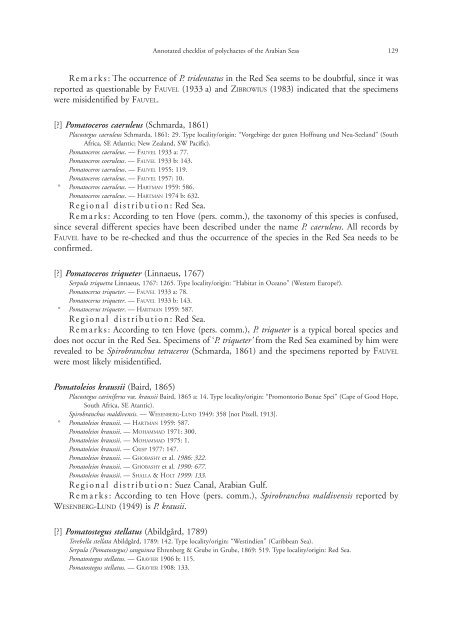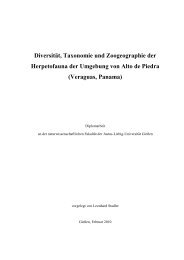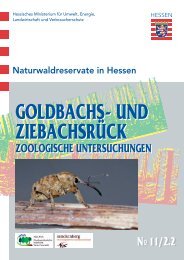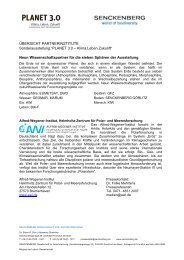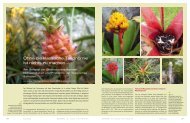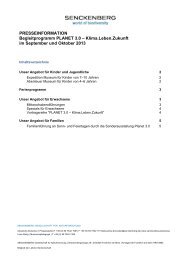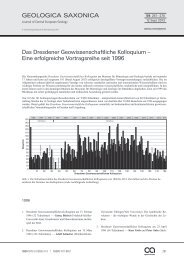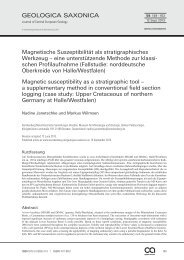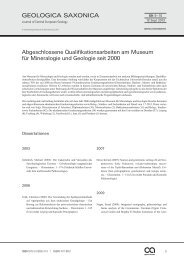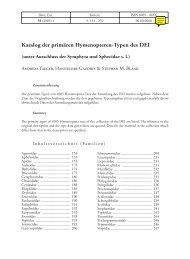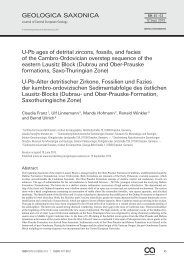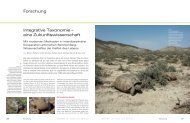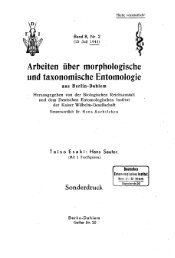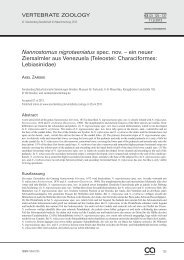Annotated checklist of the polychaete species of the ... - Senckenberg
Annotated checklist of the polychaete species of the ... - Senckenberg
Annotated checklist of the polychaete species of the ... - Senckenberg
Create successful ePaper yourself
Turn your PDF publications into a flip-book with our unique Google optimized e-Paper software.
<strong>Annotated</strong> <strong>checklist</strong> <strong>of</strong> <strong>polychaete</strong>s <strong>of</strong> <strong>the</strong> Arabian Seas 129<br />
Remarks: The occurrence <strong>of</strong> P. tridentatus in <strong>the</strong> Red Sea seems to be doubtful, since it was<br />
reported as questionable by FAUVEL (1933 a) and ZIBROWIUS (1983) indicated that <strong>the</strong> specimens<br />
were misidentified by FAUVEL.<br />
[?] Pomatoceros caeruleus (Schmarda, 1861)<br />
Placostegus caeruleus Schmarda, 1861: 29. Type locality/origin: “Vorgebirge der guten H<strong>of</strong>fnung und Neu-Seeland” (South<br />
Africa, SE Atlantic; New Zealand, SW Pacific).<br />
Pomatoceros caeruleus. — FAUVEL 1933 a: 77.<br />
Pomatoceros coeruleus. — FAUVEL 1933 b: 143.<br />
Pomatoceros caeruleus. — FAUVEL 1955: 119.<br />
Pomatoceros caeruleus. — FAUVEL 1957: 10.<br />
° Pomatoceros caeruleus. — HARTMAN 1959: 586.<br />
Pomatoceros caeruleus. — HARTMAN 1974 b: 632.<br />
Regional distribution: Red Sea.<br />
Remarks: According to ten Hove (pers. comm.), <strong>the</strong> taxonomy <strong>of</strong> this <strong>species</strong> is confused,<br />
since several different <strong>species</strong> have been described under <strong>the</strong> name P. caeruleus. All records by<br />
FAUVEL have to be re-checked and thus <strong>the</strong> occurrence <strong>of</strong> <strong>the</strong> <strong>species</strong> in <strong>the</strong> Red Sea needs to be<br />
confirmed.<br />
[?] Pomatoceros triqueter (Linnaeus, 1767)<br />
Serpula triquetra Linnaeus, 1767: 1265. Type locality/origin: “Habitat in Oceano” (Western Europe?).<br />
Pomatocerus triqueter. — FAUVEL 1933 a: 78.<br />
Pomatocerus triqueter. — FAUVEL 1933 b: 143.<br />
° Pomatocerus triqueter. — HARTMAN 1959: 587.<br />
Regional distribution: Red Sea.<br />
Remarks: According to ten Hove (pers. comm.), P. triqueter is a typical boreal <strong>species</strong> and<br />
does not occur in <strong>the</strong> Red Sea. Specimens <strong>of</strong> ‘P. triqueter’ from <strong>the</strong> Red Sea examined by him were<br />
revealed to be Spirobranchus tetraceros (Schmarda, 1861) and <strong>the</strong> specimens reported by FAUVEL<br />
were most likely misidentified.<br />
Pomatoleios kraussii (Baird, 1865)<br />
Placostegus cariniferus var. kraussii Baird, 1865 a: 14. Type locality/origin: “Promontorio Bonae Spei” (Cape <strong>of</strong> Good Hope,<br />
South Africa, SE Atantic).<br />
Spirobranchus maldivensis. — WESENBERG-LUND 1949: 358 [not Pixell, 1913].<br />
° Pomatoleios kraussii. — HARTMAN 1959: 587.<br />
Pomatoleios kraussii. — MOHAMMAD 1971: 300.<br />
Pomatoleios kraussii. — MOHAMMAD 1975: 1.<br />
Pomatoleios kraussii. — CRISP 1977: 147.<br />
Pomatoleios kraussii. — GHOBASHY et al. 1986: 322.<br />
Pomatoleios kraussii. — GHOBASHY et al. 1990: 677.<br />
Pomatoleios kraussii. — SHALLA & HOLT 1999: 133.<br />
Regional distribution: Suez Canal, Arabian Gulf.<br />
Remarks: According to ten Hove (pers. comm.), Spirobranchus maldivensis reported by<br />
WESENBERG-LUND (1949) is P. krausii.<br />
[?] Pomatostegus stellatus (Abildgård, 1789)<br />
Terebella stellata Abildgård, 1789: 142. Type locality/origin: “Westindien” (Caribbean Sea).<br />
Serpula (Pomatostegus) sanguinea Ehrenberg & Grube in Grube, 1869: 519. Type locality/origin: Red Sea.<br />
Pomatostegus stellatus. — GRAVIER 1906 b: 115.<br />
Pomatostegus stellatus. — GRAVIER 1908: 133.


